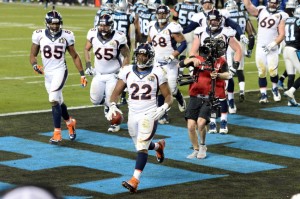Friend of the program Bryan Frye is back for another guest post. As regular readers know, Bryan operates his own fantastic site, http://www.thegridfe.com. You can view all of Bryan’s guest posts here, and follow him on twitter @LaverneusDingle.
Despite a fourth trip to the Super Bowl, 2015 has been the worst year of Peyton Manning’s storied career. Statistically speaking, he has never been worse, even as a 22 year old rookie starting all sixteen games for a 3-13 team. Relative to league average, Manning produced the worst completion rate, yards per attempt, touchdown rate, interception rate, passer rating, and adjusted net yards per attempt of his career. Manning ranked last among the 36 qualifying passers in Adjusted Net Yards per Attempt. And his normally stellar sack rate also took a hit, with the second worst output of his career (behind only 2001).
If we look to advanced metrics to try to uncover some hidden gem about his performance that may be overlooked by standard box score stats, we don’t have much luck. ESPN’s QBR (which only goes back to 2006, mind you) takes into account far more than any other popular metric, and it normally adores Manning. From 2006-2014 (excluding 2011, obviously), Manning ranked 1st, 3rd, 1st, 1st, 1st, 1st, 2nd, and 3rd in Total QBR. This year, he ranked 30th with a subpar 45.0 rating.
Football Outsiders’ DVOA and DYAR don’t do Manning any favors either. Not only was 2015 by far the worst season of his career by both metrics, it was also the only below average season of his career. From 1998-2014, his average season was 32.47% better than average by passing DVOA. His worst season by the metric was a 7.70% effort as a doe-eyed rookie. Over that same period, he averaged 1,664 passing DYAR per season, and his average season was worth 2.89 DYAR per pass. This year, Manning was 26.00% below average, as measured by DVOA, and he lost 328 DYAR from his career total. His -0.95 DYAR per play was easily worse than his previous low of 1.18 in his inaugural season.
If the stats aren’t enough, the infamous “eye test” also backs up the belief that this was Manning’s worst-ever season. He struggled to jive with Gary Kubiak’s offense, especially when asked to run bootlegs and throw on the run. His limited power to make pre-snap adjustments, in concert with his decreased mobility, resulted in him taking more abuse in the pocket than he ever had before. He threw errant passes and made uncharacteristically poor decisions, causing him to lead the league in interceptions until week 17, despite missing six games. He struggled with nagging injuries, had the worst game of his entire career, and was benched for an inexperienced and marginally talented fourth-year backup. [continue reading…]



